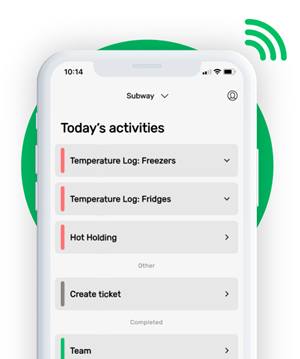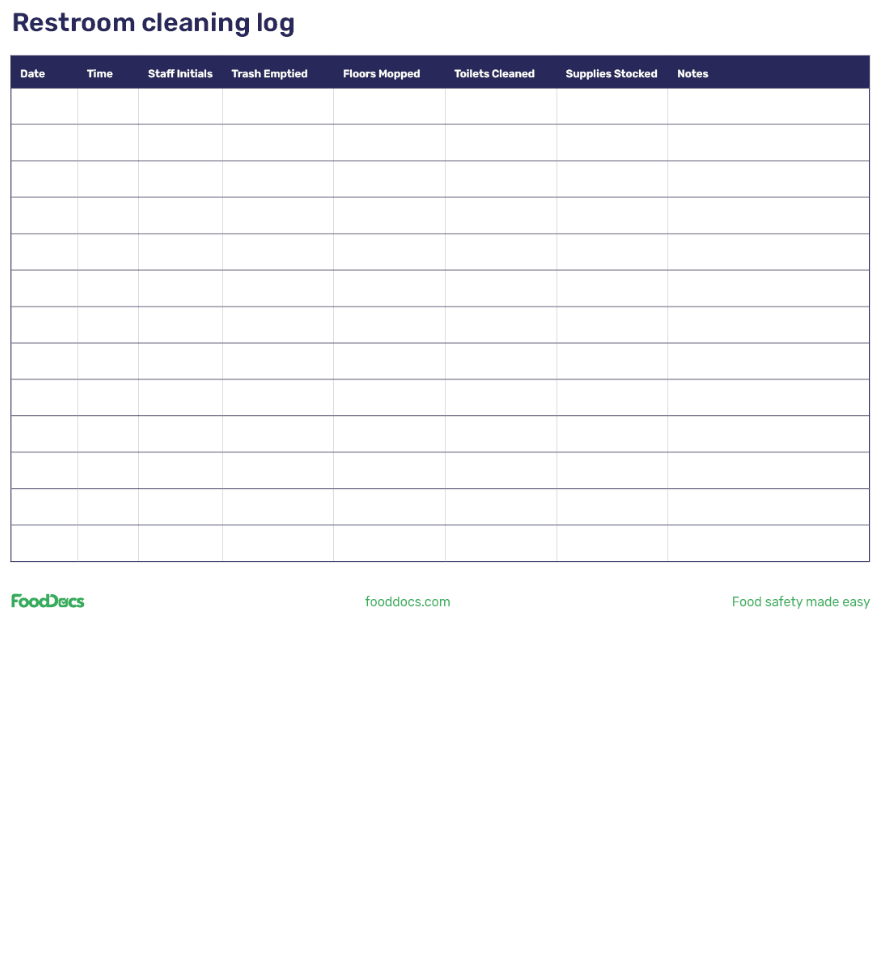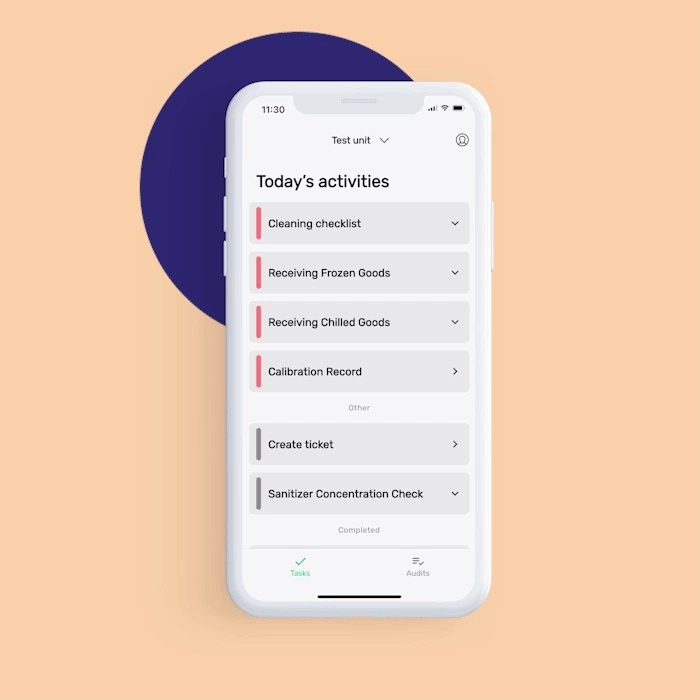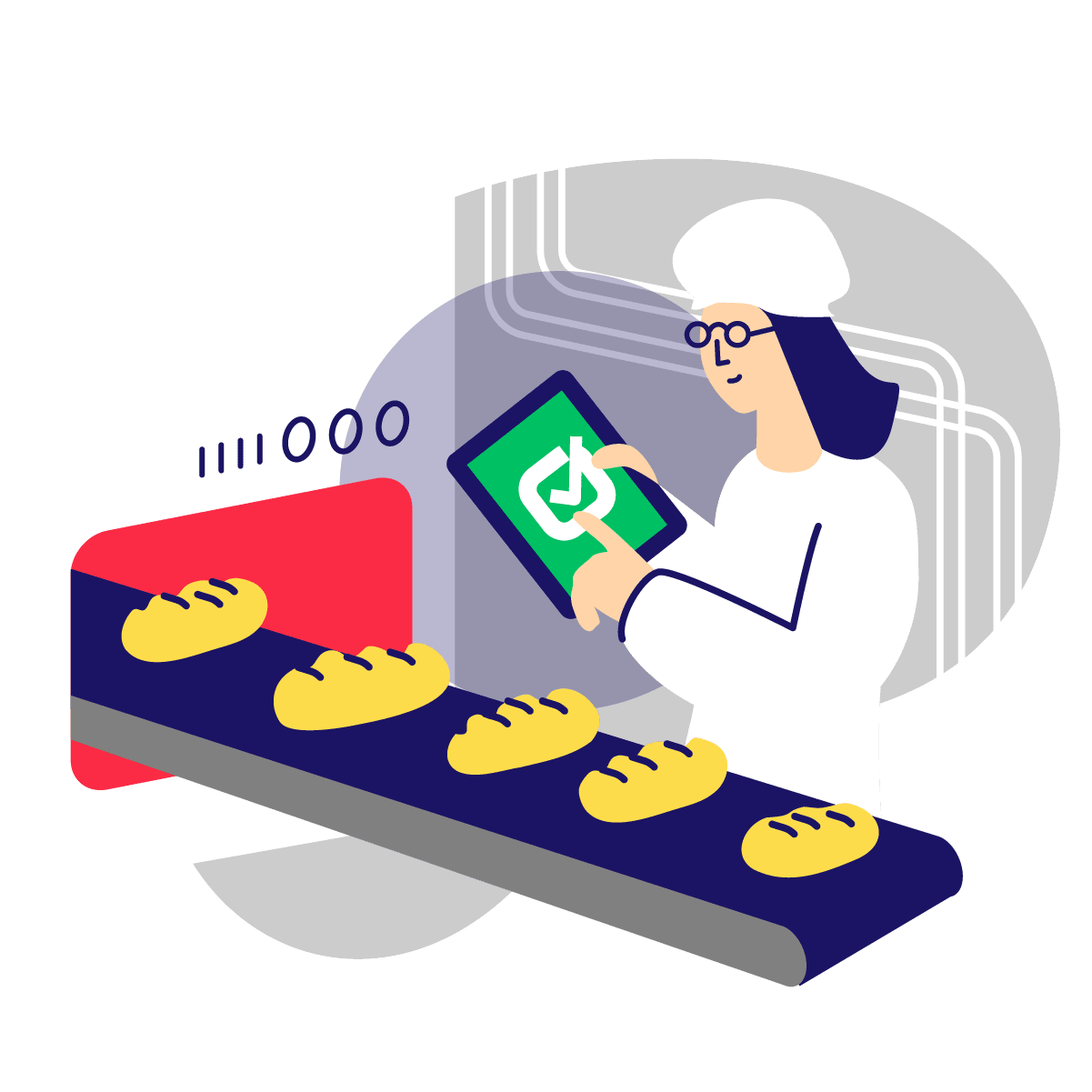Clean the restroom thoroughly every day and check it every hour during busy times.
Restroom Cleaning Checklist and Log Template | Free Download


This is how our Digital Food Safety platform saves 20% of your time on daily tasks:
- Get upcoming task notifications
- Add data into the app
- Check the status of tasks in real-time

When food safety was still handled on paper, I typically spent a couple of hours per day getting the papers and going around checking or completing tasks… Now I can sit down and it's just all there in one place. It takes me 5-10 minutes.
Ruth B.
Store Manager
Keeping restaurant bathrooms spotlessly clean is not just about appearances, but a key indicator of proper food safety and customer satisfaction. A dirty restroom can turn away diners and even pose health risks.
Below, we provide a comprehensive restaurant bathroom cleaning checklist (daily, weekly, and monthly tasks), best practices for cleaning and disinfecting restrooms, and guidance on using a cleaning log.
By the end, you'll be equipped to ensure your team (from executive chefs to line cooks or any staff responsible for restrooms) can maintain a safe, hygienic environment for everyone.
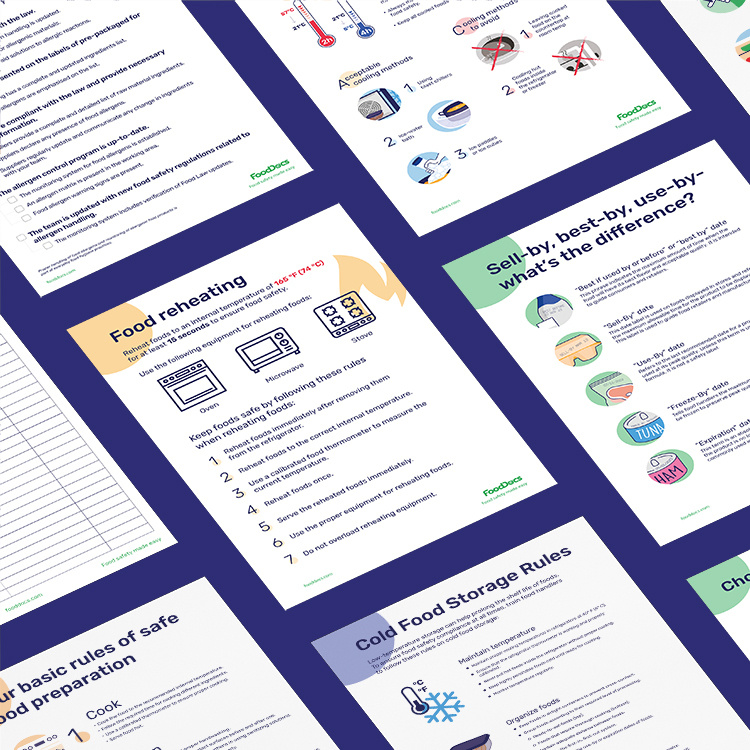
Get these 6 free restaurant food safety resources
Key takeaways
-
-
Disinfectant only works if it stays wet, so let spray sit for about five minutes before wiping.
-
Always clean from top to bottom, finishing with the floor, to keep dirt from spreading.
-
Keep separate cloths in different colors for toilets and other surfaces to stop cross-contamination.
-
Replace trash, soap, and paper supplies before they run out so guests always have what they need.
-
Schedule deeper tasks because weekly and monthly routines keep mold and stains from building up.
-
A simple checklist works best when staff sign off every restroom check on a clear log sheet.
-
Avoid kitchen rags, harsh bowl cleaner on counters, and abrasive pads that can damage surfaces.
-
Common slip‑ups like wiping too soon or skipping low spots leave odors and grime behind.
-
Train every new team member on the checklist and dwell times so the standard never slips.
Why do clean restaurant restrooms matter?
Clean restaurant restrooms matter because a spotless, well-maintained restaurant restroom signals to customers that your establishment values cleanliness and cares about their comfort.
As unfortunate as it seems that we have to address a question with an answer so obvious, a clean restroom is often seen as a reflection of your restaurant’s overall hygiene standards. Customers take note. One survey from Tork Global found that the state of a restaurant’s bathroom strongly influences whether guests return.
Nearly 50% of individuals surveyed keep track of public locations – including businesses – where they’ve had a poor restroom experience to avoid those locations in the future. That number jumps to 73% for restaurant or café patrons who say their decision to return is impacted by a poor restroom experience.
Beyond impressions, unsanitary restrooms can harbor bacteria, viruses, and odors that risk the health of both customers and staff. In the foodservice industry, this is especially crucial: you don’t want germs from the bathroom finding their way to kitchen or dining areas.
Moreover, health regulations and agencies like OSHA have specific requirements for restroom cleanliness in restaurants. Failing to keep the facilities clean could lead to violations during health inspections and harm your reputation. In short, clean restrooms are non-negotiable for safety, compliance, and guest experience.
Dotti Haynes
Marketing Director of HoReCa
Essity
What are the essential restroom cleaning supplies and disinfectants?
Before diving into the cleaning routine, make sure you have the proper tools and supplies on hand. Using the right products will make the job more efficient and effective. Here’s a list of essential cleaning supplies restaurants typically use as part of bathroom sanitation standard operating procedures (SSOPs):
- Disinfectant cleaner: A broad-spectrum cleaning disinfectant that can kill bacteria and viruses on surfaces (often an EPA-registered quaternary ammonium compound or a diluted bleach solution). This is used on counters, sinks, stall handles, door knobs; basically any high-touch surface.
- Toilet bowl cleaner: A specialized cleaner (usually acidic or bleach-based) for removing stains, limescale, and germs inside toilet bowls and urinals. Use this only for its intended purpose (i.e., cleaning toilet interiors) as it’s too harsh for other surfaces.
- Glass cleaner: For mirrors and any glass surfaces. Streak-free mirrors give a good impression.
- All-purpose cleaner: Useful for general surface cleaning (counters, walls, etc.) where a cleaning spray disinfectant isn’t required or as a pre-clean before disinfecting.
- Floor cleaner: A suitable floor cleaning solution (often with disinfectant) for tile or vinyl floors. Many restaurants use a mop with a bucket of disinfectant solution for restroom floors.
- Cleaning tools: Include color-coded microfiber cloths or disposable cleaning towels (to avoid spreading germs), scrub brushes (a toilet brush dedicated to each restroom for bowls, plus other brushes for grout or hard-to-reach areas), sponges (if used, sanitize or use disposable to prevent bacterial growth), and a long-handled brush or old toothbrush for detail work (e.g., cleaning around faucet bases or drain edges).
- Mop and broom: A broom and dustpan for sweeping, and a mop, ideally with a bucket. A dual-chamber mop bucket is great to keep clean solution separate from rinse water.
- Protective gear: Disposable gloves are a must to protect staff while cleaning. Also keep handy masks (for chemical fumes or odors), and even safety glasses when splashing cleaners (toilet bowl cleaner can be caustic and irritate eyes).
- Trash bags: Stock adequate trash can liners so staff can quickly replace them when emptying restroom bins.
- Air freshener: While not a substitute for cleaning, a mild air freshener or odor neutralizer can help keep the restroom smelling pleasant (some air fresheners also have disinfectant properties).
Tip: Avoid cross-contamination by using separate cleaning cloths/tools for the toilet and for other surfaces. For example, use one set of rags or paper towels for wiping sink fixtures and counters, and a different color-coded set for toilets/urinals. If using reusable cloths, launder them after each use. Some professional cleaners fold a microfiber towel into sections and use a fresh section for each area, or use numbered quadrants on a towel to ensure they never re-use a dirty spot on a clean surface.
Also, always read and follow product instructions, especially disinfectants, which often need to remain wet on a surface for a few minutes to properly kill germs (for instance, disinfectant wipes or sprays usually require a dwell time of around 5 minutes on the surface).
What should you not use when cleaning a restaurant restroom?
Some cleaning products and tools do more harm than good in a restaurant setting. Others simply don’t belong in the restroom. Here’s what to keep out of your cleaning routine to avoid safety issues, equipment damage, or cross-contamination:
- Kitchen rags or sponges: Never bring cloths from the kitchen into the restroom. Even if they’re clean, this practice increases the risk of cross-contamination.
- Abrasive scrub pads: These can scratch metal fixtures, plastic partitions, or tile surfaces. Stick to soft cloths, sponges, or brushes designed for the job.
- Scented bleach products: Some bleach-based cleaners are deodorizing only and not actually disinfectants. Always check the label for EPA registration and approved usage.
- Toilet bowl cleaner on non-toilet surfaces: It might seem efficient to use one product for everything, but bowl cleaner is usually too harsh for sinks, walls, or floors.
- Fabric hand towels: Avoid using towels or rags that don’t get sanitized between uses. Color-coded microfiber or disposable paper products are safer and more hygienic.
When in doubt, check the label and stick to the rule: each product and tool should be used only for its intended purpose. This helps protect your surfaces, your staff, and your guests.
What should a daily restaurant bathroom cleaning checklist include?
High-traffic restaurant restrooms should be cleaned thoroughly every single day, usually multiple times a day or per shift. Below is a daily cleaning checklist covering the key tasks to keep your restaurant’s bathroom clean and sanitary. Staff can use this as a guide and tick off tasks as they go:
- Refill supplies: Check all dispensers and restock as needed (e.g., toilet paper, paper towels, soap, seat covers, hand sanitizer, etc.). A clean bathroom isn’t very useful if it lacks basic supplies. Make this the first task so you don’t forget it.
- Empty trash bins: Remove all trash, sanitary napkin disposal liners, and debris from waste bins. Use a new trash bag liner in each can. (Overflowing trash not only looks bad and smells, but can attract pests.)
- Clean and disinfect surfaces: Wipe down all high-touch surfaces with a disinfectant cleaner. This includes counters, sink basins, faucet handles, door handles, stall door latches, light switches, baby changing stations, and the like. Use a clean cloth or disposable wipe, and be sure to get into corners and around fixtures. Pay special attention to surfaces at eye-level and below, since those get touched the most.
- Clean mirrors: Spray mirrors with glass cleaner and wipe them to a streak-free shine. A sparkling mirror makes the whole restroom feel cleaner. (It can help to do mirrors after wiping sinks, in case water splashes up on the mirror during sink cleaning.)
- Scrub toilets and urinals: Apply toilet bowl cleaner to the inside of each toilet bowl and urinal, letting it sit for the recommended dwell time to dissolve stains and kill germs. While it sits, wipe down the exterior of the toilet and urinal (i.e., the flush handle, seat, lid, base, etc.) with a disinfectant spray or wipe.
Finally, scrub the inside of the bowl thoroughly with a toilet brush (including under the rim where grime builds up) and flush. Don’t forget to also wipe the toilet seat on both sides with disinfectant and let it air-dry for a moment before putting it down. Use a separate damp cloth or disposable wipes for the toilet areas to avoid spreading germs to other surfaces. - Wipe partitions and walls, as needed: If you see splashes or dirt on stall partitions or walls (especially around sinks or trash cans), wipe those down with a suitable cleaner or disinfectant. Pay attention to corners and edges where grime can accumulate.
- Floor care: Sweep the restroom floor to remove dust, hair, and debris. Then mop the floor with a disinfectant cleaner solution, reaching into corners and around the toilet bases. It’s best to do this last so that any drips or debris from cleaning other parts of the restroom get cleaned up at the end. Make sure to put up a “Wet Floor” caution sign until the floor is dry to prevent slips.
- Final check: Do a once-over inspection: are the sinks and counters clean and dry? Toilets spotless? Supplies stocked? No bad odors? This final check ensures nothing was missed. Also, make sure to clean your tools. For example, rinse and disinfect the toilet brush and store it properly, and wash your hands thoroughly after removing gloves.
These daily tasks cover the basics that must be done at least once a day (often, several times per day in a busy establishment) to keep the restroom hygienic. Many restaurants find it useful to have a printed checklist in the janitorial closet or even posted in the restroom for staff to reference and initial once complete.
What should be included in weekly and monthly restroom maintenance tasks?
In addition to the daily cleaning, certain deeper cleaning and maintenance tasks should be done on a weekly and monthly basis. These help address dirty buildup in areas that aren’t covered by the everyday routine, and keep the restroom in top condition. Below are typical tasks to schedule:
Weekly tasks
- Deep clean sinks and drains: Once a week, take apart drain stoppers (if applicable) and remove any debris or gunk trapped in sink drains. Use a brush and cleaner to scrub around faucet bases and drains to prevent mineral buildup. This prevents slow drains and odors.
- Scrub tile grout: If your restroom has tiled walls or floors, scrub the tiles and grout lines weekly. Grout can discolor or grow mildew over time. A tile cleaner or mild bleach solution and a stiff brush can help keep grout lines bright and mold-free.
- Restroom stall detailing: Wipe down the partition walls, doors, and hinges of stalls thoroughly. This removes any graffiti, soap splashes, or grime that may accumulate. Check door locks to ensure they function and tighten any loose screws.
- Check fixtures and hardware: Inspect things like faucet handles, flush valves, door hooks, etc., for any looseness or leaks. Tighten screws or call maintenance if needed. Also look for any minor plumbing issues (e.g., slow-flushing toilet or dripping faucet) and fix them promptly.
- Floor drain flush: If there is a floor drain in the restroom, pour water or a mild drain cleaner down it weekly to ensure it doesn’t dry out (which can cause sewer odors) and to clear any potential clogs.
- Air out and deodorize: Even with daily air freshening, it’s good to do a more thorough odor-control weekly. This might include spraying a longer-lasting deodorizer or cleaning out any air vents or fan covers. Ensure the exhaust fan (if present) is clean and working well to vent odors.
Monthly tasks
- Ceiling and vent cleaning: Look up. Clean ceiling vents and exhaust fans to remove dust, and check ceilings and walls for mold or water stains. Wipe down any wall tiles or backsplashes from top to bottom. Dust the upper corners for cobwebs.
- Renew grout/sealant: If the restroom has tiled areas or caulking (like around sinks), inspect the grout and caulk lines monthly. Touch up or replace grout and sealant if you see cracking or mold that can’t be cleaned. Maintaining grout and caulk prevents water damage and makes daily cleaning easier (since grime won’t get into cracks).
- Deep floor cleaning: Give the floors a more intensive scrub periodically. For example, a machine scrubber or a deck brush can be used monthly to really clean tile floors and grout more deeply than mopping does. Pay extra attention to corners and less-trafficked spots where dirt might accumulate.
- Urinal maintenance: If your establishment has urinals, deep clean them at least once a month beyond the daily swish. This can include removing and cleaning the splash guards or traps, using a scale remover for any mineral deposits, and flushing the lines if needed. This prevents odors (like the notorious “urinal cake” smell) and plumbing issues.
- Polish metal fixtures: Go the extra mile monthly by polishing chrome or stainless steel fixtures (e.g., faucets, flush handles, door handles, etc.). Use a metal polish or appropriate cleaner. Shiny, spot-free fixtures give the restroom a like-new appearance.
- Detailed restock check: Take an inventory of restroom supplies and emergency items. For instance, ensure the first aid kit (if one is stored in or near the restroom) is stocked, or that sanitary napkin dispensers (if you have them) are filled. This might not apply to every restaurant, but it’s good to review any ancillary items monthly.
Spreading out these tasks weekly and monthly will prevent bigger problems. For example, regular grout care and vent cleaning stops mold before it starts, and periodic deep cleaning keeps the restroom from ever getting that “run-down” look. These tasks also tie into deep cleaning routines that many restaurants schedule and a more intensive monthly or quarterly top-to-bottom cleaning is done, including the restrooms.
What are the proper restroom cleaning procedures and best practices?
Having a checklist of tasks is important, but how you perform the cleaning also matters. An efficient technique ensures that you clean thoroughly without inadvertently spreading germs or missing spots. Here are some best practices and step-by-step procedures to follow for restroom cleaning:
Prepare the area
If possible, do restroom cleaning during a slow period or after closing to minimize customer inconvenience. Post a “Restroom Closed for Cleaning” sign or cone at the door. Make sure you’re wearing your PPE (gloves, etc.) before you start.
Start with trash and disposables
A good rule of thumb is to get rid of waste and used items first. Empty the trash cans (as noted in the daily checklist). This immediately removes sources of odor and lets you access floors and corners around the trash bins. Pick up any litter on the floor. This gives you a “clean slate” to work with.
Work top to bottom, clean to dirty
Tackle cleaner surfaces first and save the dirtiest (toilets and floors) for last. For example, you might start by dusting any high ledges or vents, then cleaning mirrors, then sinks and counters, and do the toilet and floor at the end. This way, you prevent dirty runoff from splashing onto already-clean areas.
Always clean the toilet before you mop the floor. If you mop too early, any drips from cleaning the toilet bowl or splashes could make you re-clean the floor. Ending with the floor will help you catch all final drips and debris.
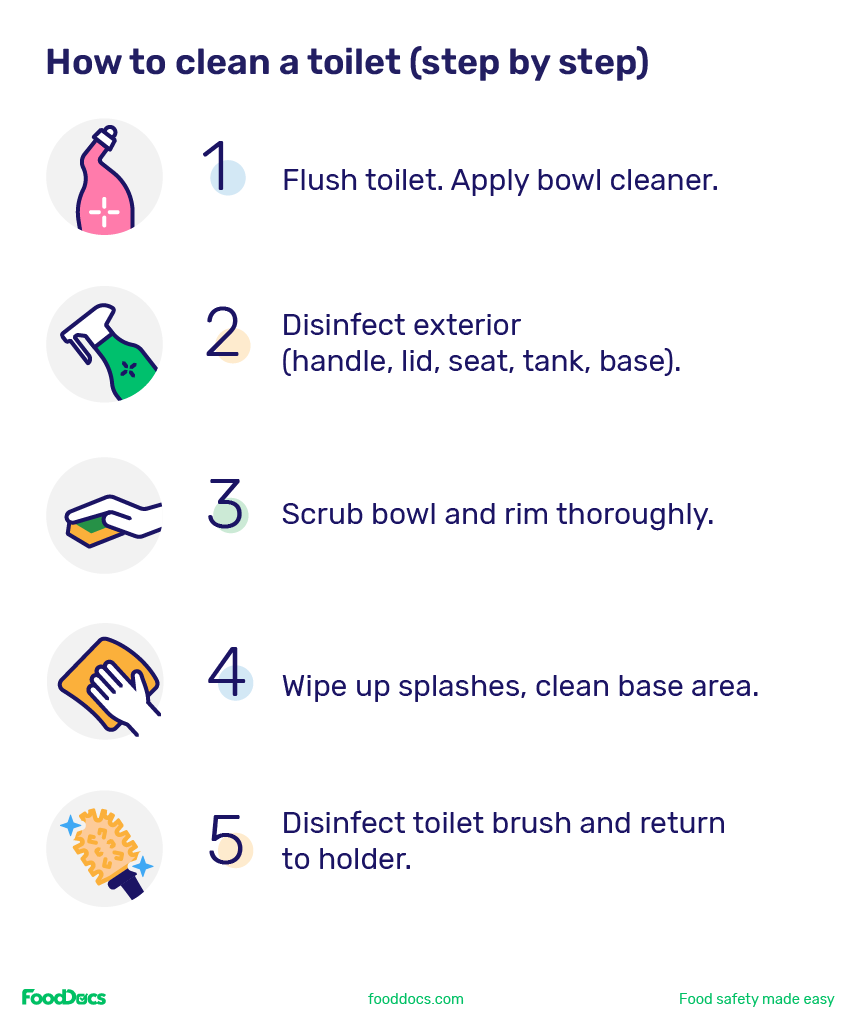
Follow the proper order for toilet cleaning
When it’s time to clean the toilet, follow a systematic approach:
- Flush the toilet first (lid down if possible to minimize aerosol spray) and then add your toilet bowl cleaner spray to the water in the bowl. Adding it early lets it start working on stains.
- While the bowl cleaner soaks, clean the outside of the toilet. Spray or wipe all exterior parts with disinfectant: the flush handle, tank, lid, seat (top and bottom), and the bowl exterior down to the base. Give the disinfectant a couple of minutes of dwell time to kill germs, then wipe it off. (Use paper towels or a disinfectant wipe for this part, and dispose of them. Remember not to use the same cloth on the sink afterward.)
- Next, scrub the bowl interior with a toilet brush. Reach up under the rim to get water jet holes clean (if those jets clog, the toilet flush weakly). Scrub thoroughly, then flush the toilet again with the lid down to rinse.
- Finally, wipe up any splashes or drips around the toilet area and floor. Don’t forget to clean the toilet brush itself after use (rinse it with the clean flushing water or a disinfectant solution) and secure it back in its holder.
Use the right cleaner for each job
It might be tempting to use one strong chemical for everything, but stick to intended uses. For instance, use that toilet bowl cleaner only inside the toilet. As noted earlier, it’s not safe for floors or counters because it could damage floor finishes or cause harmful fumes if misused.
Use glass cleaner on mirrors (other cleaners might leave streaks), and food-safe surface sanitizer on any surfaces that might contact hands that then touch food (though in restrooms this is usually just the door handle, which you already disinfect).
Don’t rush disinfection
Speed is important in a busy restaurant, but disinfection isn’t instantaneous. Surfaces like door handles, faucet knobs, and toilet flushers should stay visibly wet with disinfectant for the recommended time (often around 5 minutes) to effectively kill germs.
This means you might spray them, then clean something else (like the mirrors), then come back to wipe them after a few minutes. Plan your routine to build in this dwell time.

Pay attention to details
Some oft-forgotten spots in restrooms include: the sides of toilet tanks, the underside of the flush rim in urinals, edges of mirrors, undersides of soap dispensers (they get gunky), light switch plates, and door jambs. Make sure these are included in your cleaning passes.
A 7-step cleaning process is commonly taught in janitorial training, which includes steps like trash removal, high-dusting, surface wiping, restroom fixture cleaning, floor care, and a final inspection as the last step. That final step helps you catch any details you might have missed.
Use fresh cleaning cloths
If using reusable rags, change them out frequently. Don’t use one rag for the entire bathroom, otherwise you’re just spreading germs around.
A professional trick is to fold a microfiber cloth into quarters (i.e., the quarter‑fold or 4‑quadrant microfiber technique). Use one side for one task (e.g., wiping the sink), then flip to a clean side for the next task (wiping the baby-changing station, for example). After using all four sides, that cloth is done and you need to toss it in the laundry and grab a fresh one for more tasks.
This ensures each surface is cleaned with a clean section of cloth, greatly reducing cross-contamination. If using disposable wipes or paper towels, use a new one for each major section (one for the sink area, a new one for the toilet, etc.).
After cleaning, remember employee hygiene
Once you’ve finished cleaning and removed your gloves, always wash your hands. This seems obvious, but it’s a critical final step to protect yourself and prevent carrying any restroom germs back to the kitchen or dining area.

Following these procedures will make your cleaning more effective and keep your restroom truly sanitary. It also helps your team clean consistently because, if everyone uses the same method, you won’t miss steps.
Train your staff on these best practices, and consider doing occasional refreshers or audits of their technique.
What common mistakes that lead to dirty restaurant bathrooms?
A checklist can help keep things on track, but bathrooms still end up dirty when certain steps get skipped or rushed. Here are some of the most common oversights that cause problems:
- Using one cloth for multiple surfaces: Even with disinfectant, using the same rag to wipe the toilet and then the sink or mirror spreads germs instead of removing them.
- Skipping low spots: The bottom edge of partitions, around toilet bases, and under soap dispensers are often missed but easily build up grime.
- Waiting too long to empty the trash: Even if it’s not overflowing, a full bin looks (and smells) bad. Change it before it becomes a problem.
- Wiping before dwell time is up: If you spray and immediately wipe, you’re not giving the disinfectant time to work.
- Focusing only on what’s visible: Smells, sticky floors, and faint smudges all shape a customer’s experience — even if they’re subtle.
Even small slip-ups add up. Reviewing these pitfalls with your team can help everyone stay consistent and aware of what truly makes a restroom clean.
How often should you clean and deep clean restaurant bathrooms?
Frequency is a common question: How often should you be cleaning the restroom?
The short answer: Clean it as frequently as needed to keep it clean. At minimum, once a day deep cleaning is recommended for all restrooms. The U.S. CDC and most health guidelines say restaurant restrooms should be cleaned at least daily. However, most restaurants will need to clean much more often than that, especially during busy service times.
Many establishments follow an hourly restroom check schedule. For example, staff might inspect and lightly clean the restroom every hour (or every 30 minutes during peak times) to ensure nothing is amiss.
A famous example: McDonald’s has stated that their crews check and clean their toilets every 30 minutes, and even every 15 minutes during rush periods. This ensures restrooms stay clean despite heavy traffic. While not every restaurant may need such frequency, it highlights the importance placed on cleanliness by successful chains.
Ultimately, your cleaning frequency should be tailored to your volume. A small cafe with 20 customers a day won’t need restroom attention as often as a highway fast-food restaurant with hundreds of visitors.
Monitor your restrooms
If you frequently find messes or low supplies between the once-a-day cleaning, increase the checks. It’s better to prevent a mess or supply outage than react after a customer complains.
During service, it’s wise to do quick wipe-downs and restocks periodically. This might include:
- Quickly wiping sink areas and checking that toilets are flushed and presentable.
- Emptying overflowing trash if needed.
- Mopping up any major spills immediately (for safety as well as cleanliness).
- Ensuring an adequate stock of supplies at all times (no one should walk out because there was no toilet paper!).
Assign someone each shift to be responsible for these interim restroom checks. A clipboard log (described in the next section) mounted inside the restroom door is a great way to implement this because staff can sign off each check.
Deep cleaning frequency
In addition to daily and hourly upkeep, plan for regular deep cleans of the restroom. Many restaurants do a more intensive cleaning weekly and an extra-thorough deep clean monthly. Deep cleaning means doing tasks like scrubbing all wall tiles, machine-scrubbing floors, de-scaling faucets and toilets (removing mineral deposits), washing walls, etc.
A monthly deep clean, for example, might involve completely clearing out the restroom (removing movable items like trash cans), then using a pressure washer or steam cleaner on floors and walls, or waxing the floor if applicable. It may also involve pulling apart light fixtures to clean, or resealing grout as mentioned earlier.
High-volume establishments might deep clean more often. Some quick-service restaurants schedule a “shutdown” of certain areas for deep cleaning every week. Others hire professional cleaning services periodically to steam clean restrooms. The goal is: no area of the restroom should be neglected just because daily staff cleaning doesn’t cover it. By hitting those deep clean tasks on a schedule, you ensure the restroom stays like new.
How long should a restroom cleaning take?
A thorough cleaning isn’t an all-day job, but it does require some time. The cleaning industry uses a rule of thumb that each restroom “fixture” (toilet, urinal, sink) takes about 3 minutes to clean when following all the steps (not including deep soak times).
So if your restroom has, say, 2 sinks, 2 toilets, and 1 urinal (5 fixtures), a top-to-bottom cleaning might take roughly 15 minutes for one person in ideal conditions.
In reality, factoring in mopping floors and letting disinfectant sit, it could be around 20 to 30 minutes to do it properly. During an open-hours quick check (where you might just wipe surfaces and restock), it should be much faster and only take a couple of minutes if there's no big mess.
The key is to schedule enough time and staff so that restroom cleaning isn’t rushed or skipped. For example, at the end of the night, don’t allocate only 5 minutes for the closer to clean the bathroom. That’s not realistic.
If you are a manager, build these cleaning tasks into the work schedule. During busy shifts, make sure someone can break away to check the restroom. It’s as critical as any kitchen duty in terms of food safety culture and customer experience.
Lastly, remember that cleaning logs and documentation can help determine if frequency is adequate. If logs show frequent complaints or issues, that’s a sign you need to increase cleaning intervals.
Download the restaurant restroom cleaning log and checklist
To maintain high standards day in and day out, it’s extremely helpful to use a restroom cleaning log. This is a simple but powerful tool: a sheet (often laminated or in a binder) where staff record each cleaning or check of the restroom. We’ve provided a free downloadable restroom cleaning log template (checklist format) that you can use in your restaurant. Here’s why and how to use it:
Why use a restaurant bathroom cleaning log?
A log creates accountability and consistency. It serves as proof that cleaning was done regularly, which is useful for internal oversight and even for health inspectors. In many jurisdictions, having a documented cleaning schedule for restrooms is considered best practice.
A log can also help identify recurring issues. For example, if staff keep noting a leaky sink or frequently replenishing soap more than expected, management can spot a maintenance or supply issue.
What does the log include?
Typically, a restroom cleaning log (or restroom checklist sheet) has columns for:
- Date and Time of the cleaning or check
- Initials or signature of the Employee who did it
- Checkboxes or notes for key tasks (e.g., stocked supplies, toilet cleaned, floor mopped, etc.)
- A spot for any Comments/Issues noticed (e.g., “leaky faucet reported to manager” or “need more paper towels in storage”)
Our template includes daily tasks and also allows space for weekly deep-clean tasks so you can integrate all duties into one form. It’s printable and can be kept on a clipboard or hung in the restroom (some restaurants place it on the inside of the restroom door or near the sink where it’s discreet but accessible).
Get a free Restroom Cleaning Log Template
How to use the restroom cleaning checklist PDF effectively
Set a schedule and assign responsibility
First, decide how often staff should sign off the log. Many restaurants do it hourly. Others do it by shift (e.g., mid-shift and end of shift). Customize the template to fit your needs, whether it’s hourly, after lunch rush, etc.
Clearly assign who is responsible for each check (e.g., “Server on duty” or a specific cleaner). Each person should know it’s their job at that time to clean the restroom and record it.
Train staff on what to check
Ensure everyone knows that signing the log isn’t just ticking a box. They must actually verify cleanliness. Provide the checklist of what to do during each check.
For example, verify toilet is clean and flushed, wipe sink if needed, refill supplies, empty trash if 3/4 full, etc.). The log should match these items so it’s straightforward. Staff should mark tasks as completed and note any issues immediately during the check.
Encourage notes and reporting
If an employee finds a problem they can’t fix on the spot (like a broken soap dispenser or a clogged toilet) while checking the restroom, they should note it in the log’s comments and inform a manager. The log creates a paper trail of such issues. For instance, if multiple entries note “women’s toilet clogging at 7pm,” you know there’s a recurring issue to address.
Management review
A supervisor or manager should review the logs regularly (e.g., daily or weekly). This isn’t about mistrust; it’s about quality control. Managers can verify that entries are being made on time and tasks done.
If the log shows any missed checks or recurring problems, use that data to improve operations by maybe adding an extra check at a certain time, or retrain staff on a particular cleaning step. A quick glance at the log during a shift lets a manager see if the last check was done when it should have been.
Keep the log accessible and updated
The log only works if it’s easy to use. Keep pens handy nearby. If it’s a paper sheet, replace it when it fills up. For example, a daily log sheet can be replaced each day, or use a single sheet where a week’s worth of entries can be recorded.
Our template is printable, but you could also adapt it to a digital checklist app if your restaurant uses one (many modern solutions exist for digital facility checklists).
Leverage the data
Over time, you might collect a stack of old logs. These are more than just compliance records; they’re useful data. Look through them periodically to spot trends.
- Are weekends requiring more mid-day cleanings than weekdays?
- Did a certain new cleaning product reduce how often something got dirty?
Such insights can help you optimize your restaurant bathroom cleaning schedule and inventory (for example, stocking more toilet paper on Friday evenigs or Saturday mornings if logs show it runs out faster on weekends).
Using a restroom cleaning log fosters a culture of accountability. Employees know that their initials on that sheet mean they are taking ownership of the restroom’s condition at that time. And when everyone takes ownership, the restroom stays consistently clean.
Plus, customers do notice these logs on occasion. Seeing a recently signed-off cleaning log can reassure a guest that the facility is well maintained (just as seeing a filthy restroom with no record of cleaning would do the opposite).
Print that checklist (or use our template), post it, and make it a routine part of restroom maintenance. It turns a potentially neglected duty into a regular, trackable task.
Implementing a thorough cleaning checklist and a regular log system, restaurant restrooms can remain hygienic, fresh-smelling, and inviting for guests.
With well-trained staff, the right supplies, and diligent bathroom cleaning schedules, you can ensure your restrooms reflect the same high standards of cleanliness as the food you serve. A clean restroom means guests are more likely to trust your overall sanitation, feel comfortable, and come back again. And that’s good for business.
Digital tools can streamline these efforts by sending reminders, logging completions, and making checklists mobile-friendly for teams in the kitchen.
Try digitizing your restaurant restroom cleaning checklist with food safety software
Keeping a restaurant restoom cleaning checklist on paper is a solid start for your monitoring efforts. But it won't be able to scale as your restaurant grows, along with all your other paper-based food safety tasks.
You'll end up with too much paper and the risk of damaged or lost sheets over time. At FoodDocs, we have developed an automatic, digital solution for your cleaning and sanitation tasks. With our digital solution, you would not have to worry if your employees will remember the tasks that need to be done daily, weekly, and monthly.
When you use our digital solution, you can get the following benefits:
- Our digital solution can help your employees remember every cleaning task with a smart notification system. This feature alerts the responsible cleaner to remind them of the cleaning or sanitation checklist task on time.
- You will get detailed instructions on correctly performing deep cleaning procedures to guide food employees in performing every task and ensure their effective application.
In addition, our digital Food Safety Management System can also help restaurant owners and managers save time:
- Switching to a digital food safety management system would only take an average of 15 minutes with our solution. All you need to do is answer a few basic questions about your business operations, and our artificial intelligence-powered system will do the rest.
- Using our digital solution's real-time dashboard, you can save 20% of your time supervising your team. With this feature, you will always be updated with the status of your business, including sanitation aspects.
- Save time finding and organizing all of your digital documents using the digital cloud storage that comes with our digital solution.
 On top of running a more efficient cleaning operation, FoodDocs can be your first step to becoming more sustainable. No more paper-based monitoring forms and checklists for your team.
On top of running a more efficient cleaning operation, FoodDocs can be your first step to becoming more sustainable. No more paper-based monitoring forms and checklists for your team.
Michael Worbanski
Human Resources and Operations Safety Specialist
Gruppo Terroni
Our digital solution was created by food safety experts with efficiency and high standards of food safety in mind. With our help, you can achieve food safety compliance in the foodservice industry with very little effort and protect your consumers effectively all the time.
Start your digital food safety journey by using our free 14-day trial. With this trial, you can experience the convenience and effectiveness that our solution can bring to your team.
